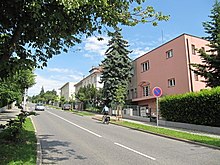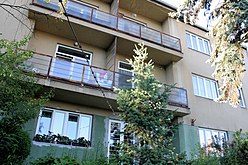Otto Eisler: Difference between revisions
m →Biography: fixed spacing |
mNo edit summary |
||
| (45 intermediate revisions by 32 users not shown) | |||
| Line 1: | Line 1: | ||
{{Infobox |
{{Infobox architect |
||
| ⚫ | |||
|image = |
|image = |
||
|image_size = (if image is smaller than 250px) |
|image_size = (if image is smaller than 250px) |
||
|caption = |
|caption = |
||
| ⚫ | |||
|nationality = [[Czech Republic|Czech]] |
|nationality = [[Czech Republic|Czech]] |
||
|birth_date = {{birth date|1893|6|1}} |
|birth_date = {{birth date|1893|6|1|df=y}} |
||
|birth_place = [[Bystřice nad Pernštejnem]] |
|birth_place = [[Bystřice nad Pernštejnem]], [[Margraviate of Moravia|Moravia]], [[Austria-Hungary]] |
||
|death_date = {{death date and age|1968|7|27| |
|death_date = {{death date and age|1968|7|27|1893|6|1|df=y}} |
||
|death_place = [[Brno]] |
|death_place = [[Brno]], [[Czechoslovakia]] |
||
| |
|practice = |
||
|significant_buildings= |
|significant_buildings= |
||
|significant_projects = |
|significant_projects = |
||
| Line 16: | Line 15: | ||
|awards = |
|awards = |
||
}} |
}} |
||
| ⚫ | '''Otto Eisler''' (1 June 1893 – 27 July 1968) was a Czech architect, noted for his contributions to [[International style (architecture)|International style]] in architecture.<ref>{{cite book |last1= Kroupa |first1= Jiří |title= Otto Eisler a racionální purismus, aneb: problém obytného domu ve 30. letech|trans-title=Otto Eisler and Rational Purism or Questions of the Residential Home in the 1930s|series= Výtvarné Brno 1918-1938 |isbn= 80-7027-007-1 }}</ref><ref>{{cite news |title=In a Czech city, '30s modernism lives on |first= Ruth Ellen |last= Gruber |url=https://www.nytimes.com/2008/04/09/travel/09iht-trbrno.1.11804780.html?_r=1 |newspaper= The New York Times |date= 2008-04-09 |access-date= 2010-04-03 }}</ref> He was Jewish and is a survivor of the [[Auschwitz]] death camp. |
||
| ⚫ | |||
| ⚫ | '''Otto Eisler''' (June |
||
==Biography== |
==Biography== |
||
[[File:Brno, Lipová.jpg|thumb|left|Semi-detached villa, Brno, Lipová Street]] |
|||
| ⚫ | Eisler was educated at the [[Deutsche Technische Hochschule |
||
| ⚫ | |||
[[File:Namesti Svobody. Fortepan 51347 crop.jpg|thumb|''Obchodní dům JEPA'']] |
|||
| ⚫ | Eisler was educated at the [[Deutsche Technische Hochschule Brünn]] over the course of ten years, with a likely interruption for military service during World War I. During his studies, he worked at studios in Vienna. Upon graduation, he worked in the architectural practices of [[Heinrich Tessenow]] and [[Walter Gropius]] before founding his own firm. He also took part in managing his family's business, including his brothers' (Artur, Hugo, Leo, and Moriz) construction company.<ref>{{cite web |url= http://www.archiweb.cz/architects.php?type=arch&action=show&id=450|title= Otto Eisler |publisher= Archiweb |language= cs |access-date= 2010-04-03}}</ref> |
||
He was subject to Nazi persecution during the [[German occupation of Czechoslovakia]] because he was both Jewish and a suspected [[Homosexuality|homosexual]]. In April 1939, he was arrested by the [[Gestapo]] and imprisoned in the prison at [[Špilberk]], where he was apparently tortured. When furloughed, he fled to Norway, where he arrived on February |
He was subject to Nazi persecution during the [[German occupation of Czechoslovakia]] because he was both Jewish and a suspected [[Homosexuality|homosexual]]. In April 1939, he was arrested by the [[Gestapo]] and imprisoned in the prison at [[Špilberk]], where he was apparently tortured. When furloughed, he fled to Norway, where he arrived on 21 February 1940. After Norway was [[Operation Weserübung|invaded]] by Germany, he tried to flee to Sweden but was shot and wounded only a few yards from the border, and then [[Jewish deportees from Norway during World War II|deported]] to [[Auschwitz]] on the [[SS Donau (1929)|SS ''Donau'']]. There he was reunited with his brother Mořic (Moriz), with whom he survived the [[Death marches (Holocaust)|death march]] to [[Buchenwald]].<ref>{{cite news |url= http://findarticles.com/p/articles/mi_m1571/is_n52_v10/ai_16284369/|title=Philip Johnson: Life and Work (book review) |first= Eric |last= Gibson |date= 26 December 1994 |work= Insight on the News|access-date= 2010-04-03 }}</ref><ref name=docomomo>{{cite web |url=http://www.docomomo.cz/index/architect/58?lang=en/|title=Otto Eisler |publisher= Docomomo |access-date= 2010-04-03 }}</ref><ref>{{cite web |url= http://www.arkivverket.no/URN:NBN:no-a1450-db20100218331645.jpg |title= Spørreskjema for jøder i Norge |date= 6 March 1942 |publisher= Riksarkivet |location= Oslo |language= no |trans-title=Questionnaire for Jews in Norway }}</ref> |
||
He was liberated from Buchenwald and returned to Brno to resume his architectural career; he also took over the woodcutting business his deceased brother left to his heirs. He married his cousin Gertruda Kenderová, née Hermannová, in 1946. The family company was nationalized in 1948, and Eisler found work first in his own business, and subsequently at the Botanical Gardens of [[Masaryk University]].<ref name=docomomo/> He acted as the chairman of [[Brno Zoo]] from 1950 to 1953.<ref name=brnzoo>{{cite web |
He was liberated from Buchenwald and returned to Brno to resume his architectural career; he also took over the woodcutting business his deceased brother left to his heirs. He married his cousin Gertruda Kenderová, née Hermannová, in 1946. The family company was nationalized in 1948, and Eisler found work first in his own business, and subsequently at the Botanical Gardens of [[Masaryk University]].<ref name=docomomo/> He acted as the chairman of [[Brno Zoo]] from 1950 to 1953.<ref name=brnzoo>{{cite web|url=http://www.zoobrno.cz/about-us/history/|title=History of the Brno Zoo|publisher=Brno Zoo|location=Brno|archive-url=https://web.archive.org/web/20100421045001/http://www.zoobrno.cz/about-us/history/|archive-date=2010-04-21|access-date=2010-04-03|url-status=dead}}</ref> |
||
In addition to his professional interests in architecture, Eisler was also an avid painter, gardener, book collector, and horticulturist. Several works of art that were stolen by the Nazis were restored to his estate in the 2000s. He is buried in the Jewish cemetery in Brno.<ref name=jmuseumcz>{{cite web |url=http://www.jewishmuseum.cz/en/acultbrnoarch.htm|title=Evening programs, March 2009 |
In addition to his professional interests in architecture, Eisler was also an avid painter, gardener, book collector, and horticulturist. Several works of art that were stolen by the Nazis were restored to his estate in the 2000s. He is buried in the Jewish cemetery in Brno.<ref name=jmuseumcz>{{cite web |url=http://www.jewishmuseum.cz/en/acultbrnoarch.htm|title=Evening programs, March 2009 |publisher= Jewish Museum in Czechoslovakia |location= Prague |archive-url=https://web.archive.org/web/20070612004046/http://www.jewishmuseum.cz/en/acultbrnoarch.htm|archive-date=2007-06-12|access-date= 2010-04-03 |url-status=dead}}</ref><ref name=brnoenc>{{cite web |url=http://www.brna.cz/home-mmb/?acc=profil_osobnosti&load=3188&cel_publication=1|title=Ing. arch Otto Eisler |date= 27 July 2009 |publisher= Osobnosti |location= Prague |archive-url=https://web.archive.org/web/20110718170049/http://www.brna.cz/home%2Dmmb/?acc%3Dprofil_osobnosti%26load%3D3188%26cel_publication%3D1|archive-date=2011-07-18|access-date= 2010-04-03 |url-status=dead}}</ref> |
||
==Notable works== |
==Notable works== |
||
* |
* House for two brothers, Neumannova 10, Brno, 1930–1931 (built for himself and Mořic Eisler). |
||
| ⚫ | * Synagogue in 13 Skořepka street, Brno, 1934 (the only remaining synagogue in Brno).<ref>{{cite web|url=http://brnonow.com/2009/10/ethnic-minorities-in-brno-jews/|title=Ethnic minorities in Brno: Jews|first=Michal|last=Kašpárek|work=Let me show you some cool places in Brno|date=2009-10-15|access-date=2016-05-25}}</ref> |
||
* House for two brothers, Brno, 1931 |
|||
| ⚫ | |||
| ⚫ | |||
* [[Brno Zoo]], 1949–1966. |
|||
| ⚫ | |||
* Brno zoo, 1949-1966 |
|||
==Gallery== |
|||
<gallery mode="packed" heights="110px"> |
|||
Adidas Masarykova 19-21 Brno - fasáda 2.jpg|Dům Wittreich a Deutsch, Masarykova 19-21 |
|||
Adidas Masarykova 19-21 Brno 1.jpg|Dům Wittreich a Deutsch, Masarykova 19-21 |
|||
Brno, Údolní 72.JPG|Údolní 72 |
|||
Brno, Botanická 6.jpg|Botanická 6 |
|||
Nájemní dům Kamenomlýnská 14 Brno 1.jpg|Kamenomlýnská 14 |
|||
SZPI building in Brno.jpg|Běhounská 10 |
|||
Eislerova vila - brána.jpg|Neumannova 10, Villa of Otto Eisler |
|||
</gallery> |
|||
==References== |
==References== |
||
| Line 41: | Line 51: | ||
{{Reflist}} |
{{Reflist}} |
||
==Literature== |
|||
* KAMENÍK, Jan. Vzpomínka na architekta Eislera, jednoho ze zakladatelů ZOO Brno. ZOOreport. Září 2008, roč. X., čís. 3, s. 8. |
|||
* KLENOVSKÝ, Jaroslav. Brno židovské, historie a památky osídlení města Brna. Brno: ERA, 2002. |
|||
* PELČÁK, Petr; ŠKRABAL, Jindřich; WAHLA, Ivan. Otto Eisler. Brno: Obecní dům Brno, 1998. |
|||
{{Authority control}} |
|||
{{DEFAULTSORT:Eisler, Otto}} |
{{DEFAULTSORT:Eisler, Otto}} |
||
[[Category:1893 births]] |
[[Category:1893 births]] |
||
[[Category:1968 deaths]] |
[[Category:1968 deaths]] |
||
[[Category:People from Bystřice nad Pernštejnem]] |
|||
[[Category:People from the Margraviate of Moravia]] |
|||
[[Category:Czech Jews]] |
[[Category:Czech Jews]] |
||
[[Category:Czech architects]] |
[[Category:Czech architects]] |
||
[[Category:20th-century Czech architects]] |
|||
[[Category:Jewish architects]] |
[[Category:Jewish architects]] |
||
[[Category:Jewish emigrants from Nazi Germany to Norway]] |
|||
[[Category:Auschwitz concentration camp survivors]] |
[[Category:Auschwitz concentration camp survivors]] |
||
[[Category:Buchenwald concentration camp survivors]] |
[[Category:Buchenwald concentration camp survivors]] |
||
[[Category:The Holocaust in Norway]] |
|||
[[cs:Otto Eisler]] |
|||
Latest revision as of 18:08, 5 June 2024
Otto Eisler | |
|---|---|
| Born | 1 June 1893 |
| Died | 27 July 1968 (aged 75) |
| Nationality | Czech |
| Occupation | Architect |
Otto Eisler (1 June 1893 – 27 July 1968) was a Czech architect, noted for his contributions to International style in architecture.[1][2] He was Jewish and is a survivor of the Auschwitz death camp.
Biography
[edit]


Eisler was educated at the Deutsche Technische Hochschule Brünn over the course of ten years, with a likely interruption for military service during World War I. During his studies, he worked at studios in Vienna. Upon graduation, he worked in the architectural practices of Heinrich Tessenow and Walter Gropius before founding his own firm. He also took part in managing his family's business, including his brothers' (Artur, Hugo, Leo, and Moriz) construction company.[3]
He was subject to Nazi persecution during the German occupation of Czechoslovakia because he was both Jewish and a suspected homosexual. In April 1939, he was arrested by the Gestapo and imprisoned in the prison at Špilberk, where he was apparently tortured. When furloughed, he fled to Norway, where he arrived on 21 February 1940. After Norway was invaded by Germany, he tried to flee to Sweden but was shot and wounded only a few yards from the border, and then deported to Auschwitz on the SS Donau. There he was reunited with his brother Mořic (Moriz), with whom he survived the death march to Buchenwald.[4][5][6]
He was liberated from Buchenwald and returned to Brno to resume his architectural career; he also took over the woodcutting business his deceased brother left to his heirs. He married his cousin Gertruda Kenderová, née Hermannová, in 1946. The family company was nationalized in 1948, and Eisler found work first in his own business, and subsequently at the Botanical Gardens of Masaryk University.[5] He acted as the chairman of Brno Zoo from 1950 to 1953.[7]
In addition to his professional interests in architecture, Eisler was also an avid painter, gardener, book collector, and horticulturist. Several works of art that were stolen by the Nazis were restored to his estate in the 2000s. He is buried in the Jewish cemetery in Brno.[8][9]
Notable works
[edit]- House for two brothers, Neumannova 10, Brno, 1930–1931 (built for himself and Mořic Eisler).
- Synagogue in 13 Skořepka street, Brno, 1934 (the only remaining synagogue in Brno).[10]
- Synagogue, Uherský Brod, 1946.
- Brno Zoo, 1949–1966.
Gallery
[edit]-
Dům Wittreich a Deutsch, Masarykova 19-21
-
Dům Wittreich a Deutsch, Masarykova 19-21
-
Údolní 72
-
Botanická 6
-
Kamenomlýnská 14
-
Běhounská 10
-
Neumannova 10, Villa of Otto Eisler
References
[edit]- ^ Kroupa, Jiří. Otto Eisler a racionální purismus, aneb: problém obytného domu ve 30. letech [Otto Eisler and Rational Purism or Questions of the Residential Home in the 1930s]. Výtvarné Brno 1918-1938. ISBN 80-7027-007-1.
- ^ Gruber, Ruth Ellen (2008-04-09). "In a Czech city, '30s modernism lives on". The New York Times. Retrieved 2010-04-03.
- ^ "Otto Eisler" (in Czech). Archiweb. Retrieved 2010-04-03.
- ^ Gibson, Eric (26 December 1994). "Philip Johnson: Life and Work (book review)". Insight on the News. Retrieved 2010-04-03.
- ^ a b "Otto Eisler". Docomomo. Retrieved 2010-04-03.
- ^ "Spørreskjema for jøder i Norge" [Questionnaire for Jews in Norway] (in Norwegian). Oslo: Riksarkivet. 6 March 1942.
- ^ "History of the Brno Zoo". Brno: Brno Zoo. Archived from the original on 2010-04-21. Retrieved 2010-04-03.
- ^ "Evening programs, March 2009". Prague: Jewish Museum in Czechoslovakia. Archived from the original on 2007-06-12. Retrieved 2010-04-03.
- ^ "Ing. arch Otto Eisler". Prague: Osobnosti. 27 July 2009. Archived from the original on 2011-07-18. Retrieved 2010-04-03.
- ^ Kašpárek, Michal (2009-10-15). "Ethnic minorities in Brno: Jews". Let me show you some cool places in Brno. Retrieved 2016-05-25.
Literature
[edit]- KAMENÍK, Jan. Vzpomínka na architekta Eislera, jednoho ze zakladatelů ZOO Brno. ZOOreport. Září 2008, roč. X., čís. 3, s. 8.
- KLENOVSKÝ, Jaroslav. Brno židovské, historie a památky osídlení města Brna. Brno: ERA, 2002.
- PELČÁK, Petr; ŠKRABAL, Jindřich; WAHLA, Ivan. Otto Eisler. Brno: Obecní dům Brno, 1998.







